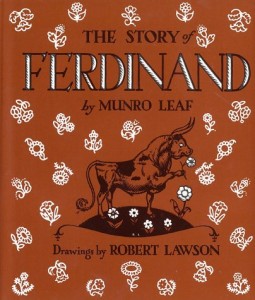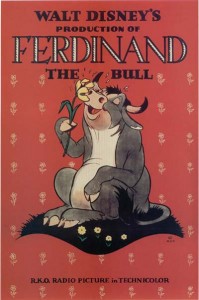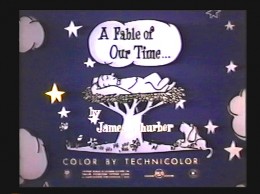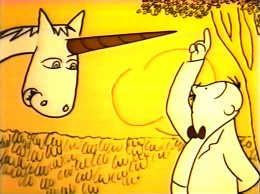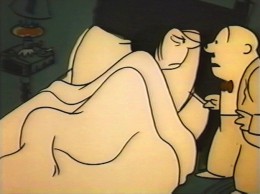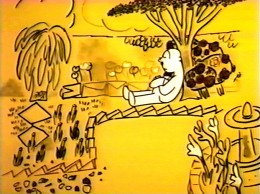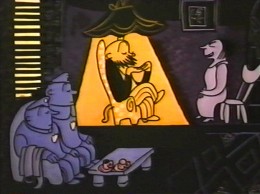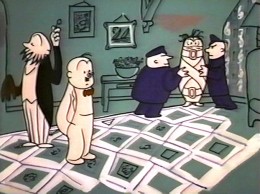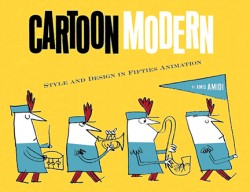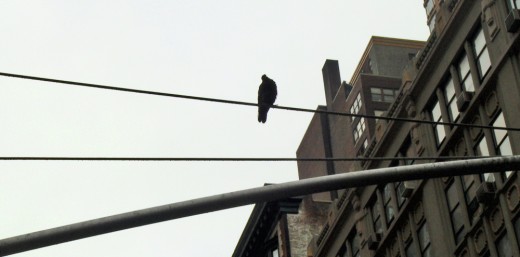Category ArchiveCommentary
Animation &Commentary &UPA 06 Jun 2007 07:55 am
Unicorns In The Garden
If you think back to how children’s books were adapted in animation prior to the 1950′s, you might think of Ferdinand the Bull by Munro Leaf with illustrations by Robert Lawson. Disney’s oscar winning short followed the story closely but ignored the book’s sensitive illustrations. Disney’s short went so far as to caricature Disney and a number of his animators in the cartoon style of the film.
Or you might think of E.H. Shepard‘s delicate watercolors for Kenneth Grahame‘s book, The Wind In The Willows. This delicacy was completely lost when the Disney artists revised the characters, in a somewhat brash cartoon way, for their film. The same was true of Disney’s adaptation of Shepard’s Reluctant Dragon. Shepard didn’t fare well even into the ’60s when Disney artists adapted his Winnie the Pooh to animation.

There are many other variations on this theme wherein animators completely rework beautiful illustrations of children’s book illustrators and rework stories of the book authors. (For one of the vilest variations look at William Steig’s stunning book, Shrek and compare.)
In 1952, UPA successfully and faithfull adapted Ludwig Bemelman’s book and style of painting to animation. Their film Madeline was a very successful short which was nominated for the Oscar. Almost a year later, UPA decided to adapt James Thurber’s whimsical story, The Unicorn In The Garden, to animation.
Thurber was a New Yorker cartoonist and doodler cum cartoonist. He was enormously successful at his trade, and the book which included “Unicorn In The Garden” was The Thurber Carnival. We know that UPA was considering the entire book of short stories as an animated feature and were calling it Men, Women and Dogs. The feature was scripted. For whatever reason (I’m sure someone out there knows, and I assume it has something to do with Joseph McCarthy), the feature was abandoned, and the short was completed.
They remained absolutely faithful to Thurber’s story and drawing style even though the very short story had only one drawing (and not one of Thurber’s best.) I’ve placed both the story and animated film at the end of this post if you want to compare.
Off the top of my head, I can only think of two other occasions that Thurber’s style was adapted to animation. Both the Jack Lemmon vehicle, The War Between Men and Women, and the tv show, My World and Welcome To It, which starred William Windom, adapted Thurber to animation as an aside to the “cartoonists” featured in the live action. Both were produced by Melville Shavelson and had similar setups – daydreaming cartoonist bumbles through his life with his alter ego being represented by the animation.
The original UPA short, to me, is beautifully animated, designed (around Thurber’s B&W drawing style hence the limited and delicate colors of the film), and sensitive to the original intentions of the author/illustrator. The film story is told with an absolute minimum of dialogue, the animation virtually carries the tale.
I remember seeing this for the first time when I was young and enjoying the seemingly innocent (or is he?) husband as he tries to share his discovery of the Unicorn in their garden with his cynical and sarcastic wife. This wasn’t something I’d seen in animated cartoons before. It wasn’t for children; it was for adults, and I felt like an adult watching it. The film offered a sophistication that Deputy Dawg didn’t. My feelings haven’t changed for the film. I love the psychiatrist who virtually sits his way through the film. Yes, I still absolutely enjoy this film.
The short also set the stage for children’s book adaptations in the future. This is a type work I’ve done often, and I like to think that I’m carrying on the tradition of this film as well as the original Madeline. It’s also something I enjoy doing. I honestly think there’s something that enlarges your own abilities when you can master another’s style and incorporate your own personality into it.
But, of course, that’s all my own opinion.
Here‘s the original story by James Thurber:
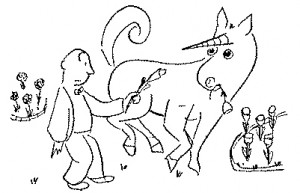 Once upon a sunny morning a man who sat in a breakfast nook looked up from his scrambled eggs to see a white unicorn with a golden horn quietly cropping the roses in the garden. The man went up to the bedroom where his wife was still asleep and woke her. “There’s a unicorn in the garden,” he said. “Eating roses.” She opened one unfriendly eye and looked at him.
Once upon a sunny morning a man who sat in a breakfast nook looked up from his scrambled eggs to see a white unicorn with a golden horn quietly cropping the roses in the garden. The man went up to the bedroom where his wife was still asleep and woke her. “There’s a unicorn in the garden,” he said. “Eating roses.” She opened one unfriendly eye and looked at him.
The original Thurber illustration .
“The unicorn is a mythical beast,” she said, and
turned her back on him. The man walked slowly downstairs and out into the garden. The unicorn was still there; now he was browsing among the tulips. “Here, unicorn,” said the man, and he pulled up a lily and gave it to him. The unicorn ate it gravely. With a high heart, because there was a unicorn in his garden, the man went upstairs and roused his wife again. “The unicorn,” he said,”ate a lily.” His wife sat up in bed and looked at him coldly. “You are a booby,” she said, “and I am going to have you put in the booby-hatch.”
The man, who had never liked the words “booby” and “booby-hatch,” and who liked them even less on a shining morning when there was a unicorn in the garden, thought for a moment. “We’ll see about that,” he said. He walked over to the door. “He has a golden horn in the middle of his forehead,” he told her. Then he went back to the garden to watch the unicorn; but the unicorn had gone away. The man sat down among the roses and went to sleep.
As soon as the husband had gone out of the house, the wife got up and dressed as fast as she could. She was very excited and there was a gloat in her eye. She telephoned the police and she telephoned a psychiatrist; she told them to hurry to her house and bring a strait-jacket. When the police and the psychiatrist arrived they sat down in chairs and looked at her, with great interest.
“My husband,” she said, “saw a unicorn this morning.” The police looked at the psychiatrist and the psychiatrist looked at the police. “He told me it ate a lilly,” she said. The psychiatrist looked at the police and the police looked at the psychiatrist. “He told me it had a golden horn in the middle of its forehead,” she said. At a solemn signal from the psychiatrist, the police leaped from their chairs and seized the wife. They had a hard time subduing her, for she put up a terrific struggle, but they finally subdued her. Just as they got her into the strait-jacket, the husband came back into the house.
“Did you tell your wife you saw a unicorn?” asked the police. “Of course not,” said the husband. “The unicorn is a mythical beast.” “That’s all I wanted to know,” said the psychiatrist. “Take her away. I’m sorry, sir, but your wife is as crazy as a jaybird.”
So they took her away, cursing and screaming, and shut her up in an institution. The husband lived happily ever after.
Moral: Don’t count your boobies until they are hatched.
__________________Now check out the film below if you haven’t seen it recently.
Directed by Bill Hurtz
Story by James Thurber
Animation by Phil Monroe, Rudy Larriva, Tom McDonald
Design & Color by Robert Dranko
Music by David Raksin
Production Manager Herb Klynn
Produced by Stephen Bosustow
Comic Art &Commentary &Daily post &Fleischer 03 Jun 2007 08:11 am
Willard Bowsky et al
There are a number of interesting posts I’d like to call to your attention:
- First and foremost, Joe Campana on his site, Who and Where, has a post about Fleischer animator Willard Bowsky who died in battle during World War II.
Bowsky was a big guy at the Fleischer studio, and he’s rarely reaped the praise deserved for his work there. He was one of those at Fleischer’s who moved into the position of animator when there was a virtual exodus for the West Coast by many of Fleischer’s animators. Losing Dick Huemer, Sid Marcus, George Stallings and George Ruffle left only Ted Sears and Grim Natwick as animators. Suddenly Al Eugster, Shamus Culhane, George Cannata, Seymour Kneitel, Bill Henning and Willard Bowsky all received promotions.
Over the years I’d asked quite a few of the Fleischer veterans, who I’d met, for some information about Bowsky, but rarely did I get more than an anecdote about him.
 This is the sort of comment I heard. It comes from Shamus Culhane‘s book Talking Animals and Other People. (I’m not one to take Culhane’s usually biased comments verbatim, though undoubtedly there’s some truth in the statement.
This is the sort of comment I heard. It comes from Shamus Culhane‘s book Talking Animals and Other People. (I’m not one to take Culhane’s usually biased comments verbatim, though undoubtedly there’s some truth in the statement.
- Within a very short time some of the neophyte animators began to exhibit real talent as filmmakers. One was Willard Bowsky. He was about twenty-one at the time, a loudmouthed, opinionated fellow, who had a ready answer for every problem, political, artistic, or ethnic. He was probably the only person in the studio who was openly anti-Semitic. It didn’t seem to bother Max or Dave, even when people complained. While they admitted that it was probably true, they had none of the fierce defensiveness about Jewishness that developed later as a result of the rise of the Nazis.
According to the standards of the studio, Willard drew very well and had a great appreciation for contemporary music, so he was given sound tracks like “Minnie the Moodier” and “Stick Out Your Can Here Comes the Garbage Man.” He would even go into ecstasies over Cab Calloway records.
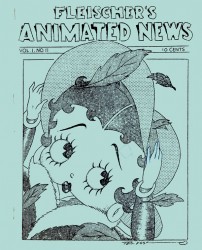 With my background of classical music, I thought Calloway sounded like jibberish and avoided those assignments like a plague. While Bowsky really couldn’t draw well enough to compete with West Coast films, he did make some of the better jazz cartoons in the studio because he loved the music.
With my background of classical music, I thought Calloway sounded like jibberish and avoided those assignments like a plague. While Bowsky really couldn’t draw well enough to compete with West Coast films, he did make some of the better jazz cartoons in the studio because he loved the music.
Willard lived at home with his parents and took no part in the usual Saturday night saturnalias. He was what one might call a pre-McCarthy, gung ho, ail-American Babbitt, an avid reader of the New York Mirror, with social convictions to match. He believed that all the unemployed were just being lazy, and intimated that anybody with ambition could succeed in this country, freely offering himself as a shining example.
Joe Campana really fills in a lot of gaps with his extraordinary post that details a lot of Bowsky’s life and final efforts during the war. Who and Where is becoming one of the better sites out there.
- I’m pleased to see that Will Finn has entered the Blog-writing fray. I love a good, new articulate voice to attend to. Check out his site. I’ve attached his link to my regulars. Thanks to Cartoon Brew for alerting us.
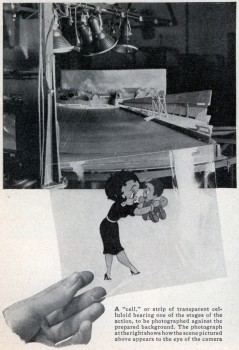 - Here’s an article from a 1936 issue of Popular Science showing how the 3D backgrounds were created for the Fleischer cartoons. The image to the left, obviously, comes from this article.
- Here’s an article from a 1936 issue of Popular Science showing how the 3D backgrounds were created for the Fleischer cartoons. The image to the left, obviously, comes from this article.
- Hans Perk posts on his blog A Film LA a 1936 Disney document about a “Gag File.” There’s always something new to dig up about the Golden Disney years. It’s a very interesting and provocative document.
 Blue Sky reports that the Tinkerbell film is finally shaping up having been wholly reworked by John Lasseter. This means that the trio of “Fairy” films can move forward. A cgi Tink, voiced by Brittany Murphy, will be coming our way. Can’t wait.
Blue Sky reports that the Tinkerbell film is finally shaping up having been wholly reworked by John Lasseter. This means that the trio of “Fairy” films can move forward. A cgi Tink, voiced by Brittany Murphy, will be coming our way. Can’t wait.
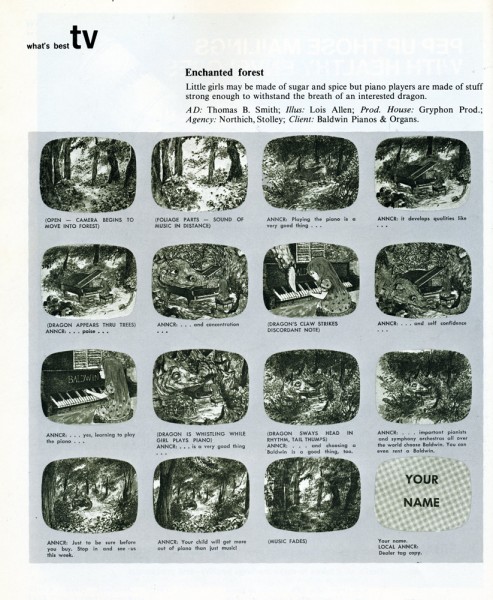 – Finally, I received an email from Howard Beckerman after meeting him at Amid Amidi‘s award ceremony. He said that he’d noticed my post which included the board by Gryphon Productions for Baldwin Pianos. (See the original post here.) Howard’s note reads:
– Finally, I received an email from Howard Beckerman after meeting him at Amid Amidi‘s award ceremony. He said that he’d noticed my post which included the board by Gryphon Productions for Baldwin Pianos. (See the original post here.) Howard’s note reads:
. . . I checked out your informative Splog and noticed Gryphon’s
. . . storyboard for the Baldwin Piano spot. It was directed by
. . . Ed Seeman and animated by Dante Barbetta and…me.
You never know what bit of info is going to turn up. It’s a great world.
Commentary &Daily post 01 Jun 2007 08:06 am
Scher with Paprika
- Today, in New York, Amid Amidi will receive the Theatre Library Association Award for his book, Cartoon Modern.
Congratulations to him for the well deserved award.
John Canemaker will be presenting the award. I’ll be there to watch (and give some notes tomorrow.)
- Last year the NY Times featured monthly reports by artist/illustrator Maira Kalman.
I waited monthly for those visual diaries. The art was stunning. But she left off doing it several months back.
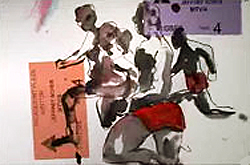 Now, the NY Times has started an animated series on its website done by animator/artist, Jeff Scher. His first piece went up on the Times and is called The Animated Life:L’Eau Life. The piece is one of Jeff’s best works, beautifully scored by Shay Lynch. (note that it loads slowly.)
Now, the NY Times has started an animated series on its website done by animator/artist, Jeff Scher. His first piece went up on the Times and is called The Animated Life:L’Eau Life. The piece is one of Jeff’s best works, beautifully scored by Shay Lynch. (note that it loads slowly.)
Unfortunately, you might have to be a subscriber of the TimesSelect to see the work.
However, I suggest you get in touch with someone you know who subscribes to the TimesSelect to see it.
 – Let me tell you about Paprika. A small group of us went last Saturday to see the film. The trailer seemed interesting and the reviews were over the top, so I was hell bent on checking it out. I’d also enjoyed Tokyo Godfather and Millenium Actress by the same director, Satoshi Kon.
– Let me tell you about Paprika. A small group of us went last Saturday to see the film. The trailer seemed interesting and the reviews were over the top, so I was hell bent on checking it out. I’d also enjoyed Tokyo Godfather and Millenium Actress by the same director, Satoshi Kon.
Paprika more resembles Millenium Actress than any other. It’s a head trip of a film that intermixes the internet with movies with dreams. I’m sorry to say, I also didn’t think it worked very well.
Right at the start of the film, we’re ushered into a dream – this is the first and only time the same, repeating dream has a beginning. The dream is interrupted as we learn that a red-headed nymph of a character, Paprika, is sharing dreams with a hard-boiled detective who is trying to solve a murder mystery. His time is up, and Paprika runs off to the lab where she turns into a scientist, Chiba. The doppelganger Chiba cum Paprika doesn’t work at all, since we don’t really know who or why one is the other.
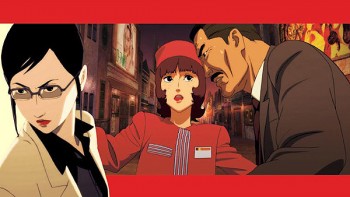 The dream machine is stolen by someone within the company – we’re never quite sure why though somehow he’ll control the world with it – and the remainder of the film is 90% dream repetition. You remain engrossed spending two hours trying to unravel the story, but in the end you’re not quite sure who is what and where you are or why?
The dream machine is stolen by someone within the company – we’re never quite sure why though somehow he’ll control the world with it – and the remainder of the film is 90% dream repetition. You remain engrossed spending two hours trying to unravel the story, but in the end you’re not quite sure who is what and where you are or why?
The film definitely needed less dream and more reality. I would have liked to have known more about the real characters and why they’re so intently pursuing this dream machine. I’m not sure I understand the value of sharing my dreams with anyone. (Copyright infringement?)
Not my kind of movie. Though, I have to say, it works only on an adult level (note I didn’t say adolescent), and that’s something that probably can’t be said about any other animated feature yet screened this year. (Only Persepolis holds out hope for adding to that roster.)
Ultimately, I can say that if you’re an Anime buff, go see Paprika; if you’re not go see The Golden Door, an excellent and beautiful French/Italian film about immigrants coming to America at the turn of the 20th Century.
Commentary &Daily post 30 May 2007 09:39 am
Kudos and Dodos
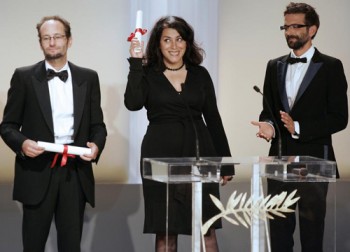 – As I mentioned on Monday, Marjane Satrapi and co-director Vincent Paronnaud is to be congratulated for their film, Persepolis having won the Jury Prize at the Cannes Film Festival. However, the film seems to be on a real hate list in Iran. An advisor to Iran’s President was furious over the prize saying that the movie promoted “Islamophobia.”
– As I mentioned on Monday, Marjane Satrapi and co-director Vincent Paronnaud is to be congratulated for their film, Persepolis having won the Jury Prize at the Cannes Film Festival. However, the film seems to be on a real hate list in Iran. An advisor to Iran’s President was furious over the prize saying that the movie promoted “Islamophobia.”
Mehdi Kalhor, a cultural adviser to President Mahmoud Ahmadinejad said, “Islamophobia in Western drama started in France and producing and highlighting the anti-Iranian film Persepolis in Cannes falls in line with this Islamophobia.”
Iranian authorities had already protested to France over the Cannes screening of the film co-directed by Satrapi, who insisted that her comic-memoir was about family and not politically oriented. Reacting to the complaint from Iran, France’s Foreign Ministry Tuesday defended the Cannes Film Festival’s decision to screen a movie that paints a bleak portrait of life after the Iranian revolution.
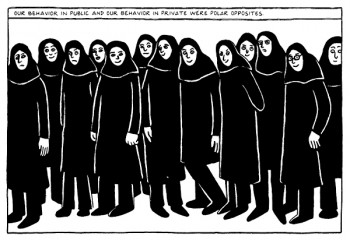 “Iranian authorities must understand that France is very attached to freedom of expression and freedom of creation,” French Foreign Ministry spokesman Jean-Baptiste Mattei said in Paris. “The festival chose the film … It was nothing to do with politics.”
“Iranian authorities must understand that France is very attached to freedom of expression and freedom of creation,” French Foreign Ministry spokesman Jean-Baptiste Mattei said in Paris. “The festival chose the film … It was nothing to do with politics.”
Marjane Satrapi, on stage to receive her award, Sunday, said: “I’ll speak for both directors. We want to express our thanks Gilles Jacob and Thierry Frémaux for having selected our film. We thank the Jury for having awarded the Prize to us. We thank the whole crew of ninety people who worked with us for two years. Personally, although this film is universal, I wish to dedicate the prize to all Iranians.”
The story made yesterday’s NYTimes and today’s Variety.
The film will open in the US this coming November.
Boy, say one thing to criticise John Krisfalusi and you may as well have offended the Iranian government. I think Stephen Worth may have finished his doctoral thesis on my website for all the fury I aroused in him.
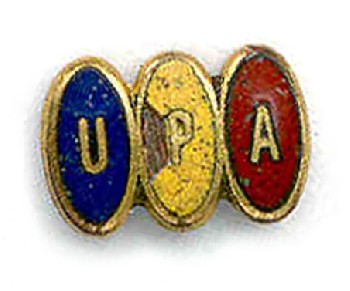 In defending, UPA on Saturday against the barbs of John Krisfalusi and his ignoble
In defending, UPA on Saturday against the barbs of John Krisfalusi and his ignoble
stance against these masterful films, I began to wonder if appreciation of these films was purely generational.
Was the generation before me, who had made these films, and mine, who appreciate them, wrong?
Was my enjoyment of many of these shorts a sign of my growing obsolescence.
N a h !
I know better. Just because there are still a lot of Picasso-haters out there, modern art isn’t wrong. Those who dislike Picasso are wrong.
Of course, UPA, like Picasso, produced a lot of swill. It was expected that any studio that wants to keep rolling has to make a lot of commmercial trash, and I think somewhere around 1953 UPA lost it, and their cartoons became mawkish.
However, even the worst of these UPA films is still interesting to me, just as I still enjoy many Terrytoons or Paramount films. I’m not going to rant about either, though.
However I do recognize the classics, and I give them their due diligence.
The mass of vehement comments wasn’t completely surprising to me. I’d once stepped in the goo of John K. before and found my mailbox full. Thank goodness I don’t live in LA or I might have had death threats. (Just joking.)
Interesting that John, who I think is a very shy guy (I don’t know him), stays behind his theories at his blog. I’ll keep checking in there, but promise not to fill up his comment box with long winded rants. I’ll use my own blog for that.
By the way, John has a good report today on the interesting interviews conducted this past weekend in Chicago. John interviewed Bill Plympton one night and Bill interviewed John the next night. Amusing.
Animation &Commentary 27 May 2007 08:21 am
Aaargh!
- I tend to stay away from John Krisfalusi‘s site because I often come away angry. John is one of the most knowledgeable, articulate and intelligent animation writers out there. His “course” in animation, built on the back of the Preston Blair primer, is priceless. I’ve followed that myself knowing full well that I still have a lot to learn about the medium.
However, John likes to taunt the world beyond his little box of fans and followers.
As promoted by Stephen Worth‘s AHAA blog (the link that led me to 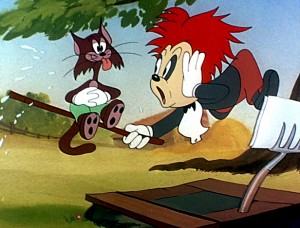 John K), a recent post had John espousing the positive “creative freedom” in 1940′s studios such as Terrytoons and Walter Lantz.
John K), a recent post had John espousing the positive “creative freedom” in 1940′s studios such as Terrytoons and Walter Lantz.
. . . . S p i t. . t a k e !. . (WHAT!!!)
As if that weren’t enough, he then posts UPA’s Unicorn In The Garden and calls it: “depressing downbeat dreary, creatively stifled drizzle.” I repeat, he’s just compared the UPA classic negatively to Terrytoons and Walter Lantz’ cartoons. (A better place, I think, to look for “dreary drizzle”.)(Dick Lundy’s creative freedom!)
. .
In later postings, atop a rough sketch from UPA he writes: “If it’s bland and sterile, it’s design.” Or he says “… and the other UPA guys decided to abandon animation, fun and lush movement and instead focus on ‘design’.” Then he praises Bill Tytla’s insipid animation and direction at Terrytoons in an ugly little short that has its own immature charm – but little else praiseworthy. There’s no lush movement or fun anywhere to be found in that short. There’s only a boxed-in, brillliant artist, Tytla, unable to work at the top of his game.
Of course all this derisive goading prompts his sycophantic fans to comment of Unicorn In The Garden:
“It’s painful to look at.”
“Upa did destroy the cartoon world.”
“… it was just a big “fuck you” to the audience.”
“Even with the better examples, there’s no denying that most of their flat designs are quite ugly. UPA sorta made it okay to do ugly animation.”
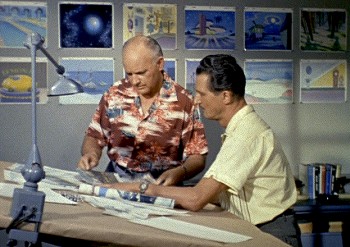 The problem is that John Krisfalusi knows full well how important the UPA break was to animation.
The problem is that John Krisfalusi knows full well how important the UPA break was to animation.
He knows that unless a group of artists broke from the 19th Century style of illustration animation would have remained a world of cute kittens and fairies, princesses and witches. History exists and we have to look at all of the influences to understand why it changed as it did.
(Beware: designers exercising creative freedom at the Lantz studio.).
Without UPA, 101 Dalmatians, Heavy Traffic, and Ward Kimball’s late success wouldn’t have existed. Without UPA, Maurice Noble’s brilliant work for Chuck Jones, Ralph Bakshi’s classic early films or Ren and Stimpy wouldn’t have existed. There had to be a break with the past – design wise – to enable other talents to take it to another level.
Milt Gross‘ style was squeezed at pre-UPA MGM, and good as his shorts were, they don’t equal the insanity of his strips. Today that can be done thanks to UPA.
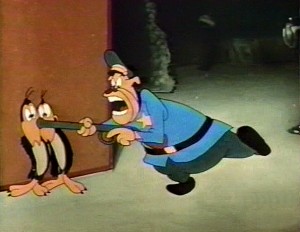 John goes into some detail about the art of Jim Tyer (but doesn’t really say why his work is great.)
John goes into some detail about the art of Jim Tyer (but doesn’t really say why his work is great.)
Mind you I think Jim Tyer was brilliantly well ahead of his time, and I’ve studied his work endlessly.
I also recognize that his animation was a GRAPHIC (read: DESIGN) distortion of his characters to pull out any inner spirit. You feel as though his pencil rushed to get out these drawings. The result is endlessly hilarious, but it also works in a larger, more subconscious way.
(Jim Tyer, free from Paul Terry’s low budgets.). . . . . .
Without the graphic changes brought about by UPA, Tyer’s work would not have been accepted by even the cheap producers at Terry’s or Famous. Tyer was endlessly put down by the animators around him at those studios, but he continued to do what he did.
Johnny Gent told me, “Jim could never hold a character.” Two of Terry’s best known assistants told me that he “couldn’t stay on model.” Thank god Bakshi appreciated Tyer’s work. Baksi also appreciated Hubley’s work. He stole from him in putting together his first feature.
Artists like Jules Engel, Bill Hurtz and Paul Julian; animators like Bobe Cannon, Grim Natwick and Art Babbitt had real creative freedom at UPA, and changed the world of animation for the better.
You don’t have to like The Yellow Submarine to recognize that it was a breakthrough, and you don’t have to like UPA’s films to recognize that it was a breakthrough. You don’t have to attack one of the great animation shorts, Rooty Toot Toot, to make your point. Especially when you’re aware of the brilliant animation and design – yes, design – in that film. It all comes together perfectly.
My gosh! Isn’t it time to have to stop defending Picasso as an artist. Michelangelo was great, but so was Pablo in his own way.
You do have to be honest, John K. You want to make a point, and you go so far over the edge thinking it’ll help your case, but it doesn’t. You’re speaking to new generations of animators, and perhaps they don’t fully understand or appreciate the history as you do. Take smaller steps in your criticism, please. And keep writing but don’t think you have to incite the world to get your point across. It’s just annoying and dishonest.
Commentary 25 May 2007 08:35 am
Animated Hope
- I have to admit that there are finally a couple of animated features I’m interested in seeing. They sound adult, intelligent and thought provoking. No, I’m not talking about 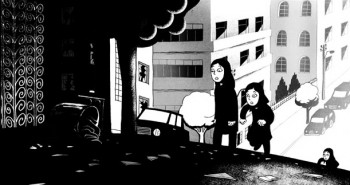 Surf’s Up with it’s tedious, jerky, completely unoriginal style of animation. I shouldn’t comment so negatively about a film I haven’t seen. But the point is I won’t see it; there’s nothing about this film that attracts my interest.
Surf’s Up with it’s tedious, jerky, completely unoriginal style of animation. I shouldn’t comment so negatively about a film I haven’t seen. But the point is I won’t see it; there’s nothing about this film that attracts my interest.
However, Persepolis has my hopes flying, and Paprika allows me to hope for the best.
Persepolis just opened at the Cannes Film Festival on Wednesday, and it will hit the US later this year. Read the opening paragraph from Lisa Nesselson‘s review in Variety:
- Any stragglers still unconvinced that animation can be an exciting medium for both adults and kids will run out of arguments in the face of “Persepolis.” Like the four-volume series of graphic novels on which it’s based, this autobiographical tour de force is completely accessible and art of a very high order. First-person tale of congenitally rebellious Marjane Satrapi, who was 8 years old when the Islamic Revolution transformed her native Teheran, boasts a bold lyricism spanning great joy and immense sorrow. In both concept and execution, hand-drawn toon is a winner.
 Sounds good enough to get me excited about animation again. It’s been a long time.
Sounds good enough to get me excited about animation again. It’s been a long time.
The film had already created a political stir when Iran, this week, officially protested the screening of the film at Cannes. This made for a very heated Q&A for Marjane Satrapi, the film’s creator and co-director, at Cannes. She refused to speak to the “irate Iranian journalists” and defended herself by saying, “I simply didn’t want to nourish this dispute. It has blown up out of proportion and I don’t want to add fuel to the fire. I accept criticism. I believe in freedom of expression and speech.” There’s a fuller article about this controversy at Bloomberg.
I’m a bit surprised that I didn’t read about this incident on any of the big animation news sites I visit.
See part of the press conference here.
See the trailer for the film here.
By the way, Marjane Satrapi wrote an Op Art/editorial for the NY Times in November, 2005. You can still read this on the Times’ site.
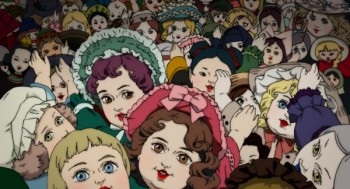 The Japanese film, Paprika, has an enticing trailer, and I’ve liked the two other films I’ve seen by the director, Satoshi Kon. Three Godfathers and Millennium Actress both were thoughtful and mature, and both were entertaining enough to make them more riveting than the average Anime. They both felt a bit too wedded to live action films for me to be completely satisfied with them, but they represented a clear voice whose work I want to follow.
The Japanese film, Paprika, has an enticing trailer, and I’ve liked the two other films I’ve seen by the director, Satoshi Kon. Three Godfathers and Millennium Actress both were thoughtful and mature, and both were entertaining enough to make them more riveting than the average Anime. They both felt a bit too wedded to live action films for me to be completely satisfied with them, but they represented a clear voice whose work I want to follow.
The film’s reviews today are sterling. All of the New York papers glowed with praise. Here are a few quotes:
-
NY Daily News‘ Elizabeth Weitzman writes: Whatever it is you’re looking for – comedy, horror, parades of singing frogs and dancing kitchen appliances – you’ll find it in Satoshi Kon’s anime adventure, a jaw-dropping feat of imagination.
Manohla Dargis in the NY Times wrote: A mind-twisting, eye-tickling wonder, this anime from the Japanese director Satoshi Kon bears little relation to the greasy, sticky kid stuff that Hollywood churns out, those fatuous fables with wisecracking woodland creatures selling lessons in how to be a good child so you can grow up to be a good citizen. Model behavior isn’t on the menu in “Paprika,†and neither are dinky songs and visuals.
and Gene Seymour of Newsday & AP wrote: Whether viewed as science-fiction in the manic, shape-shifting tradition of Philip K. Dick or as a hyperbolic analogue to the movie industry, “Paprika” is like little else you regularly experience in animated or live-action movies. Those for whom the pictorial style of Japanese anime holds no charm won’t care about its densely layered narrative or about how clever it is with its cinematic references. The rest of us can once again wonder why so few animators in this country even try to take their art to such exotic extremes.
The story about manipulating wild dreams isn’t something I’m interested in, but I’ll take the leap for the sake of this director.
Perhaps someday I’ll be enthusiastic about the opening of an American film in the same way.
Shrek 3 was one I chose to pass, despite the invitation I’d received to a screening. (Shrek #1 was ugly albeit funny; #2 was uglier and not funny; I’ve wasted enough time on this franchise to see #3. Sorry.) They’ll make enough money off it – always a positive thing when an animated film is successful – even if I don’t want to see it.
The aforementioned Surf’s Up looks like a bad blend of Madagascar and Happy Feet.
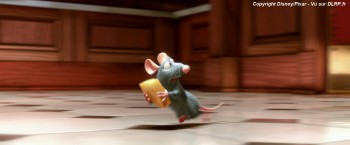 Ratatouille is probably the only one of the Hollywood films I’ll see in a theater. I do like Brad Bird‘s work. The Incredibles actually had a couple of fine acting performances that Bird had pulled from some animators. (I wish I could name the animators, but the system in cgi just doesn’t allow us to connect any hand, other than the director’s, to animated acting.) However, the nine minute clip I’ve seen from Ratatouille looks entertaining and obvious and completely impersonal in its construction. I won’t judge it, though, until I’ve seen the whole film. I do also have to say that it’s going to take some doing for me to sympathize with a rat as the lead character. (I am amused by a film, whose marketing feels compelled to tell you how to pronounce its title. That doesn’t read big box office to me.)
Ratatouille is probably the only one of the Hollywood films I’ll see in a theater. I do like Brad Bird‘s work. The Incredibles actually had a couple of fine acting performances that Bird had pulled from some animators. (I wish I could name the animators, but the system in cgi just doesn’t allow us to connect any hand, other than the director’s, to animated acting.) However, the nine minute clip I’ve seen from Ratatouille looks entertaining and obvious and completely impersonal in its construction. I won’t judge it, though, until I’ve seen the whole film. I do also have to say that it’s going to take some doing for me to sympathize with a rat as the lead character. (I am amused by a film, whose marketing feels compelled to tell you how to pronounce its title. That doesn’t read big box office to me.)
If you’d like to see the recipe for Ratatouille success, go here.
Commentary &Daily post 19 May 2007 07:02 am
Liquid Blend
 – Well, Shrek 3 opened yesterday and is onto making a crop of cash for Dreamworks Animation. Good for them.
– Well, Shrek 3 opened yesterday and is onto making a crop of cash for Dreamworks Animation. Good for them.
The reviews weren’t sterling. The most positive I saw in the NY papers came from AOScott of the NYTimes. He’s getting to be one of the reviewers I most enjoy reading for insightful, intelligent and creative writing.
This is how he ends his Shrek review:
- “Shrek,†“Shrek 2†and “Shrek the Third,†by contrast, are flat and simple, hectic and amusing without being especially thrilling or complex. Their naughty insouciance makes their inevitable lapses into sentimental moralism all the more glaring. In this movie we hear some speeches about how it’s important not to care about what other people think of you, and to be yourself above all. Yeah, fine, whatever. This doesn’t strike me as necessarily good advice, and in any case today’s wised-up kids don’t need life lessons from an ogre. But then again, the kids are not the ones who identify with Shrek as he makes his grouchy way through the life cycle.
Dreamworks last year had a charming little short called “First Flight” which was light years better than Pixar’s “Lifted.” I hope they get away from the ugly Shrek graphics and into something a little more human like that short.
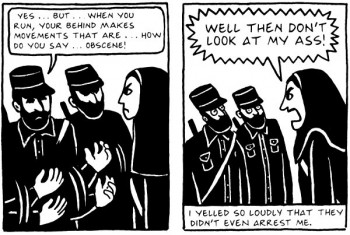 - The feature I’m waiting to see is Persepolis. The film is directed by Marjane Satrapi and Vincent Paronnaud and is adapted from the her graphic novel.
- The feature I’m waiting to see is Persepolis. The film is directed by Marjane Satrapi and Vincent Paronnaud and is adapted from the her graphic novel.
This black-and-white animated feature recounts Satrapi’s experiences growing up in Iran after the fundamentalist revolution of 1979 created a more repressive nation and a climate of fear among educated Iranians. It features the voices of Gena Rowlands and Catherine Deneuve.
A number of clips have shown up on YouTube, and it looks as original as I hoped it will be. Unfortunately all of the clips are in French, but you can figure out what’s going on.
Teaser trailer
Clip 1
Clip 2
Clip 3
The film will premiere next Wednesday & Thursday in competition at the Cannes Film Festival.
 – NY animator, Pat Smith has put together a collection of his animated shorts and calls the dvd Liquid Tales.
– NY animator, Pat Smith has put together a collection of his animated shorts and calls the dvd Liquid Tales.
The collection sells for $25 from Smith’s Blend Films site or can be bought on Amazon or in storers everywhere.
The films included in the dvd are:
Drink Delivery
Moving Along
Handshake
Puppet.
It also comes with extras. Read reviews at Blend Films.
Commentary &Photos 13 May 2007 08:09 am
Up On the Rooftops
I’ve always had something of a fascination with the rooftops in New York. There are lots of pipes and chimneys, and other paraphernalia on tar paper covered roofs. My curiosity should have pulled me off my bum to do a bit of research and find out what those bits & pieces and unidentifiable objects are.
For this reason, I often look up while walking down the street. I decided to photograph some of these things while out and about this past week. For better or worse here they are:
 a
a  b
b
Most buildings look like these three. There are the older buildings constructed in the early 20th Century (as in “a”) with a fancy ediface. They’ve been cleaned of any gargoyles or protrusions that might’ve once leaned off the face of the building – landlords didn’t want to be sued as these objects started to come loose and fall off.
 There are the sleeker, newer, less interesting buildings (as seen in “b” above) which are boring to the eye. The flat top in the foreground is not as attractive as the turreted red building in back of it.
There are the sleeker, newer, less interesting buildings (as seen in “b” above) which are boring to the eye. The flat top in the foreground is not as attractive as the turreted red building in back of it.
My favorites are the smaller, more interesting buildings built (to the left) with odd pipes and chimneys peeping out.

In the not-too-distant past, rooftops were covered with TV antennae.
This has been replaced with satellite dishes. I’m not sure which is more attractive.
I know illustrators still enjoy putting an occasional antenna on a city rooftop
or even a pair of rabbit ears atop a television set.
After all, what says TV more than an antenna? A cable box?
 d
d  e
e
I only photographed the one building, but I found that many of the early 20th Century constructions had crosses on the top. These aren’t churches, either. Perhaps in an earlier time they had some connection to a Christian organization, but today they’re very commercial. However golden globes are definitely big on the tops of many of the buildings in the City.
 e
e  f
f
Many are under maintenance; many just stand out shining.
 There are also those, such as the building on the left, which have a beautifully sculpted golden top that merely crowns the steeple of the building.
There are also those, such as the building on the left, which have a beautifully sculpted golden top that merely crowns the steeple of the building.
A lot of care went into these rooftop pieces that shone over a pre-neon city. This building, on 23rd Street and Madison Avenue, was at one time the governmental center of the city. It was a very rich area until the downtown low-lifes started encroaching, and the rich moved further uptown. The Mayor’s home, Gracie Mansion, is on 88th Street, the far East side of Manhattan.
Where does such a building keep its air conditioning equipment and water towers so prevalent on other buildings of the period? That might be asked of a lot of buildings, today, in this modern era.

Speaking of water towers, there are plenty of them. They cover the rooftops and range in sizes and shapes. Some look more industrial than others, and I’m not sure what purpose they serve.
Years ago I took my father to a show at Lincoln Center. He was an air conditioning engineer, and as we passed the large fountain in the square, he remarked that the water of the attractive fountain also served the air conditioning of the entire center. That bit of information has stuck with me for many years.
Do the water towers of the city also serve the air conditioning? Are they the remnant of an architectural solution of the past? The newer, less attractive buildings don’t seem to have these structures. I guess I have more homework to do.
 m
m  n
n
Plants, of course, proliferate on the City’s rooftops. Any way to add green to the tans and greys of Midtown is obviously optimistic.
 o
o  p
p
However, one isn’t always prepared for the variey of plants and trees one sees in the distant sky. Many fir trees abound, but obviously a homesick Californian would plant palm trees on his roof. (see “p”)
 I couldn’t help but finish with one of my favorite little buildings in town.
I couldn’t help but finish with one of my favorite little buildings in town.
It’s not so much the rooftop that’s interesting, here, but the building, itself.
You see the entire structure in this photo to the left.
.
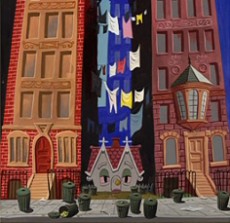
It sits on 28th Street squeezed between two larger buildings. In a way it reminds me of the “Little House” in the Disney film as designed by Mary Blair. I doubt laundry would ever have hung out of a midtown Manhattan window. They used to dry it on clotheslines on the rooftops (a bit I used in my film, The Red Shoes.)
One wonders what the story of this building can be told and what interesting landlord didn’t sell out to the money grubbers to the left and right of him. There’s a lotta history in this City.
Commentary &Puppet Animation 05 May 2007 08:06 am
More Marionettes
 - Jim Henson actually changed puppetry and the perception of puppets with personality, imagination and great craftsmanship. His hand/rod puppets were so believable that almost any other form of puppet was rejected. When he first started appearing regularly on ABC’s Jimmy Dean Show, where Rowlf the Dog became an overnight sensation, puppetry took a giant step. Once his puppets were filmed and were just as successful on the big screen as they’d been on TV, they became something bigger than puppets. Since they were originally planned for television the move to film was relatively easy, and the Muppets took the world. No wonder the show was an immediate success.
- Jim Henson actually changed puppetry and the perception of puppets with personality, imagination and great craftsmanship. His hand/rod puppets were so believable that almost any other form of puppet was rejected. When he first started appearing regularly on ABC’s Jimmy Dean Show, where Rowlf the Dog became an overnight sensation, puppetry took a giant step. Once his puppets were filmed and were just as successful on the big screen as they’d been on TV, they became something bigger than puppets. Since they were originally planned for television the move to film was relatively easy, and the Muppets took the world. No wonder the show was an immediate success.
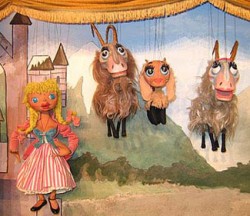 This was bad news for marionettes.
This was bad news for marionettes.
Once Bil & Cora Baird had ruled the theatrical environs on TV (Bil & Cora Baird Show and Peter & the Wolf) , in theater (Flahooley, Baker Street) and on film (Sound of Music). Yet when the very successful scene in the film, Lili, where Leslie Caron talks to Bil Baird’s marionette, moved to Broadway as the musical, Carnival, it was Jim Henson who built the puppets for the show.
A sea change had happened. The marionette had become a hand puppet.
Here’s a bit of the Bil & Cora Baird tv show:
It’s interesting that both Henson and the Bairds dabbled with stop motion animation. this is a Sesame Street piece from Henson:
Perhaps it took too long, or maybe the element of live theater was lost, but neither went beyond small attempts in the form. Stop motion wasn’t for them.
Bil & Cora Baird opened their puppet theater on 50 Barrow Street in Greenwich Village and it lived to the end of their lives. But the fame that they knew was eclipsed by the Henson success. Times change and marionettes – puppets on strings – seemed to become little more than a joke. (See Team America. The duo that attacked animation went after puppet films like Thunderbirds Are Go and Stingray.)
Now it appears that puppets on film are getting eclipsed by computer animation. When all cgi filmmakers are using their medium to create little doll-like characters straight out of Viewmaster, can a hand/rod puppet succeed? When Yoda goes from a Henson puppet to a cgi puppet, is the handwriting on the wall?
Perhaps only live theater will keep the brilliance of live puppets (including marionettes) alive. The performance of a marionette Macbeth, that I saw recently, played to a full house. Most of the audience, it seemed to me, were adults.
Time to get back to the marionette theater that has existed in Central Park for so long.
Commentary 04 May 2007 08:01 am
Brando-style Acting Animated
(Note: I wrote this piece based on Mark Mayerson’s initial comments about acting, and I’m responding to what I read there. He has expounded on those thoughts, and I should react. But I think I’ll let this post sit as it is.)
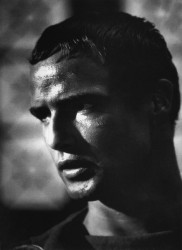 – Mark Mayerson, on his blog, offered enormous and deserved praise for Marlon Brando‘s acting. He then compared it to animation suggesting that no animator has touched the surface of Brando’s work (my phrasing – not Mark’s). This commentary had me mulling about anima-tion and animation acting for the next day or so, and I thought I should comment.
– Mark Mayerson, on his blog, offered enormous and deserved praise for Marlon Brando‘s acting. He then compared it to animation suggesting that no animator has touched the surface of Brando’s work (my phrasing – not Mark’s). This commentary had me mulling about anima-tion and animation acting for the next day or so, and I thought I should comment.
Since I’m prone to ramble, I decided not to overwork Mark’s site with my words and to post it here. Consequently, I think that you might want to read Mark’s not-very-long commentary if you want to continue; go here.
To start with, Mark ends his piece by suggesting that Gollum, the character, is probably the closest that animation has to Brando. This I have to push away from my table with one big stroke.
I don’t understand how a character could be the equivalent of Brando. Even if I thought Gollum were well animated (and I don’t even consider it animation – the way I consider Tytla’s work animation), I would have to compare it to one of Brando’s characters – Stanley, in Streetcar, perhaps.
Perhaps I misunderstand Mark’s thought here.
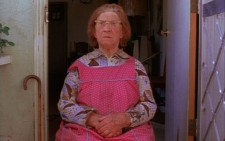 Years ago I was exiting the premiere of Errol Morris‘ first documentary feature, Gates of Heaven. I was shaken, disturbed and said so to my companion. The documentary was an anti-New Wave film. Yet, animation hadn’t even had its own New Wave! (And still hasn’t!) What hope was there for my chosen field?
Years ago I was exiting the premiere of Errol Morris‘ first documentary feature, Gates of Heaven. I was shaken, disturbed and said so to my companion. The documentary was an anti-New Wave film. Yet, animation hadn’t even had its own New Wave! (And still hasn’t!) What hope was there for my chosen field?
Intelligently, my companion reminded me of Yurij Norstein‘s masterpiece, Tale of Tales. I knew she was right; Norstein had pushed animation up to the equal of live action. The future was as much in my hands as documentaries were in Errol Morris‘ hands.
How many times since then have I reminded myself of Tale of Tales?
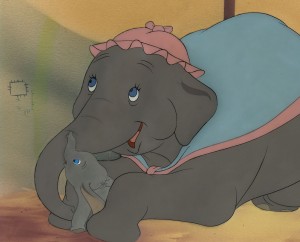 I do think there are animators who were the equivalent of Brando.
I do think there are animators who were the equivalent of Brando.
Tytla was certainly one. I think Tissa David‘s work is on a par with Brando (though I usually think of her closer to Meryl Streep – to me every bit the equal to Brando. (The divine moment in the mediocre film, Devil Wears Prada, where Streep sits in a bathrobe, with bare feet, allowing her vulnerability to escape, before hardening again, has to have been the finest acted moment in film last year.)
The fact that a handful of animators with the knowledge of their craft and the ability to use it didn’t get the work or the part is, to me, irrelevant. If Brando had only played the equivalent of Superman’s father for his entire career, we wouldn’t be talking about him. But he did play that role as well as other mediocre parts, and he played them all extremely well. He also played many masterful roles throughout his career. He gave actors a point in the sky to which they could stretch.
Tytla – there can be no doubt – was in the stratosphere. He is the one we all point to. Stromboli in Pinocchio, Chernobog in Fantasia, Dumbo under his mother’s legs, the dwarfs in Snow White. Can there be any greater acting? The fact that he was forced out of Disney’s studio to the lacking resources of Terrytoons had to affect everything he did. There was no possibility of his continuing the brilliant work. He was subjected to be Superman’s father for the rest of his career.
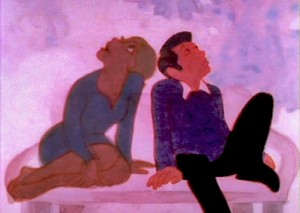 Tissa David is an animator who has made a career of the little human touches among those brilliantly drawn characters of hers. She has worked always on a very tight budget with high footage rates. She has had projects the equivalent of some of those Tytla Disney films, but she was always forced to the ground with their Independent budgets. She has had a couple of large budget projects that had poor stories and/or characters that she had to develop. The fact that she has not always had the great budgets to support her great characters has not hurt her work. She is still a great actress, and her characters – even on three’s – live. Unfortunately, most of her work has been done in the regional theater of animation where the audiences aren’t massive. However, she has made gold of what was handed her, and her talent and abilities are every bit the equal of Brando – and Streep.
Tissa David is an animator who has made a career of the little human touches among those brilliantly drawn characters of hers. She has worked always on a very tight budget with high footage rates. She has had projects the equivalent of some of those Tytla Disney films, but she was always forced to the ground with their Independent budgets. She has had a couple of large budget projects that had poor stories and/or characters that she had to develop. The fact that she has not always had the great budgets to support her great characters has not hurt her work. She is still a great actress, and her characters – even on three’s – live. Unfortunately, most of her work has been done in the regional theater of animation where the audiences aren’t massive. However, she has made gold of what was handed her, and her talent and abilities are every bit the equal of Brando – and Streep.
And there is Tale of Tales. Norstein has done it many times from that truly adult film, to Hedgehog in the Fog or The Heron and The Crane. The direction is brilliant, the filmmaking superb, and the acting equal to the greatest. The unfortunate part is that he has done so little work since the fall of the USSR. (Check out the beautiful and recent Winter Days.)
Brando’s acting style came out of the Actors’ Studio which was an outgrowth of the Group Theater which grew out of Stanislavsky. I always like to think back on a comment John Hubley told me. He said that a small number of those at the Disney were ardent advocates of Stanislavsky, but the rest of the studio couldn’t spell it. Tytla was definitely one of the advocates; just take a look at Chernobog and try to argue otherwise. Tissa came out of France at just the time that the French New Wave started to spark. She went to work under the wing of Grim Natwick who was also one of the Stanislavsky devotees.
Mark is right that there are very few people who could be tagged with such greatness. Most of those I can think of are dead or are no longer working.
These days acting techniques and stylization has grown so enormously sophisticated. Animation abilities have gone in the opposite direction. Today, in animation, it’s all about the broad gesture. I don’t think there is anyone among the young stretching – or trying to stretch – to the same heights, and I’m not sure there will be any more. Though I can hope
- By the way, you should already know that Mark Mayerson has been posting enormously  valuable information with his breakdowns and analysis of Pinocchio, scene for scene.
valuable information with his breakdowns and analysis of Pinocchio, scene for scene.
It would be wonderful if somehow Mark got this bound in a published volume. He’s just posted the seventh part of his notes on the “Mosaics” he’s been doing of this monumental film. If you have any interest in animation, you should be following these posts.
